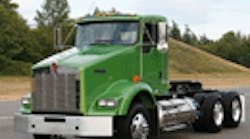When it comes to natural gas as a vehicle fuel, Kenworth Truck Co. shared high hopes and high praise with trucking industry editors yesterday at a special “Green Editor” event at the Paccar Technical Center in Mount Vernon, WA—the research, development and testing facility which supports all Paccar divisions, including Kenworth and Peterbilt Motors.
As natural gas- and diesel-powered trucks zipped around the 2-plus mi. test track with Paccar test drivers or editors at the wheel, Kenworth and Westport HD experts discussed the multiple reasons why they consider natural gas to be such a good fit for the trucking industry and such a benefit to the nation as a whole.
“The reality is that high diesel prices and evolving environmental rules are leading truck operators to seek practical solutions when it comes to their truck purchases,” said Andy Douglas, Kenworth’s national sales manager, specialty markets and a “green truck” specialist. Because of the production methods for natural gas today, domestic natural gas is both plentiful and cheap. Natural gas is currently close to $2 less than the equivalent amount of diesel fuel and the price is expected to stay ‘very flat’ over the long term, he noted.
“Natural gas pricing has decoupled from oil pricing,” Douglas told Fleet Owner. “We are producing more than we can use, so transportation represents a good emerging market for natural gas producers. We have also had many real-world successes with natural gas in fleet operations, and it shares 80 to 90% of diesel engine technology, so it is not really shifting the paradigm that much. It works in our world.”
Today, there are about 23,000 natural gas-powered vehicles operating in the U.S., mostly buses and refuse trucks, according to Douglas, but the number is growing.
“The over-the-road segment of the industry has been later to the game,” he said, “but [the use of natural-gas vehicles in that segment] is rapidly catching up.”
In addition to the cost benefits of natural gas over diesel, many carriers are being required by their shippers to make the shift to natural gas, according to Douglas.
“In many cases, fleets are being required to [use natural gas vehicles] by their shippers,” he said, citing CR England’s addition of natural gas vehicles to their fleet in support of customer Coca-Cola’s environmental goals as a case in point.
Westport HD’s Kelly Mills, Western U.S. territory sales manager, was also on hand to discuss the company’s leadership role in the natural gas engine marketplace and to field questions about CNG and LNG engines for commercial truck fleets.
“Westport owns some 66 U.S. patents,” he told the group, “and today there are over 28,000 Westport natural-gas engines deployed worldwide. Liquid natural gas, which has an energy density of about 60% of diesel fuel, makes it the best-suited for long-distance trucking.”
Mills fielded questions about how liquid natural gas (LNG) works in the Westport HD engines. When natural gas is cooled to -260 deg. F, it condenses to a liquid, he explained, where it can be stored in an LNG tank on the truck and drawn out with a pump. Then the LNG is vaporized, using excess heat from the engine coolant, and passes it through an accumulator vessel, warmed and pressurized, to the engine. At the same time, a diesel fuel pump draws and pressurizes diesel fuel from a smaller, pilot diesel tank. Both the diesel and the natural gas are injected into the combustion chamber of the engine where the diesel ignites first under pressure to then ignite the natural gas.
The ratio is about 5% diesel to 95% natural gas, but trucks using even such a small amount of diesel fuel must also make use of SCR (selective catalytic reduction) to meet engine emission standards, Mills noted. The plus: by using SCR aftertreatment, the engine achieves up to 5% improved fuel efficiency over engines without it.
When it comes to the natural gas fueling infrastructure, Mills said that the company would like to see facilities offer both CNG and LNG.
“We are encouraging building dual natural gas fueling stations,” he said, “stations that offer both CNG for passenger vehicles and lighter-duty commercial vehicles and LNG for longer-haul commercial vehicles.”
Like Douglas, Mills also noted that the build-out of the fueling infrastructure is rapidly gaining momentum, especially along major trucking corridors. The lack of readily available fueling stations has been an impediment to the use of natural gas as a vehicle fuel in the past.
Earlier in the week, about 80 customers, dealers and prospective customers also spent time at the Paccar Technical Center learning more about using natural gas trucks in commercial operations from running costs through maintenance and fueling to financing and leasing.
“We tried to cover all the elements of owning and operating natural gas trucks,” noted Douglas.
Kenworth currently offers four natural gas-powered trucks. Customers and editors had the chance to test drive a T800 day cab tractor powered by a 485 hp. Westport GX15 LNG engine and a T440 day cab tractor powered by a 320 hp. Cummins Westport ISL G in addition to comparable hybrid diesel-electric and diesel-powered trucks.



